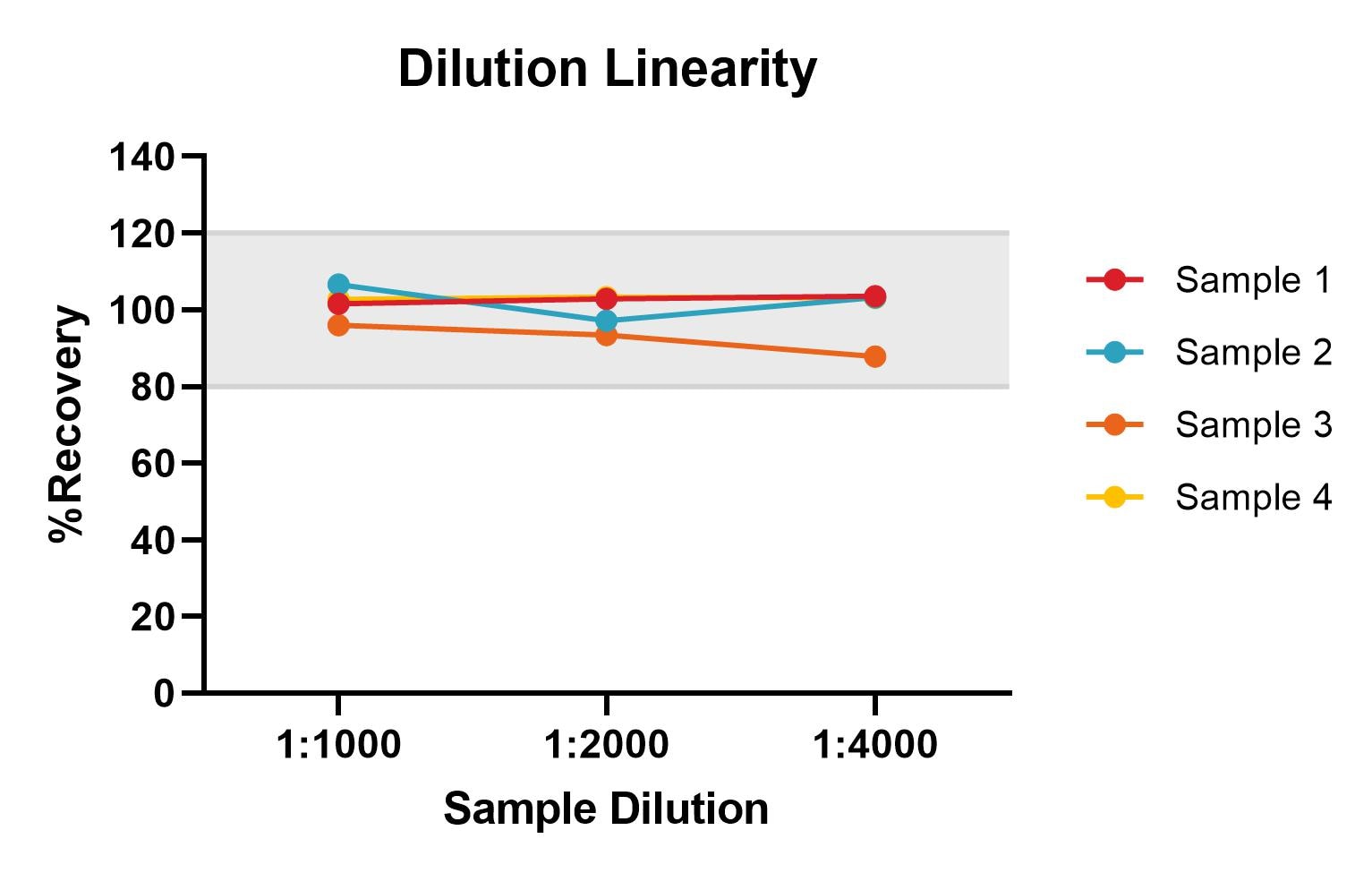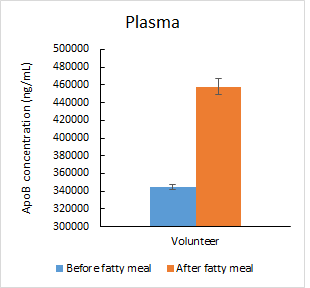Human Apolipoprotein B/ApoB ELISA Kit - Quantikine
Human Apolipoprotein B/ApoB Quantikine ELISA Kit Summary
Product Summary
Precision
Serum, EDTA Plasma, Heparin Plasma
| Intra-Assay Precision | Inter-Assay Precision | |||||
|---|---|---|---|---|---|---|
| Sample | 1 | 2 | 3 | 1 | 2 | 3 |
| n | 20 | 20 | 20 | 20 | 20 | 20 |
| Mean (pg/mL) | 284 | 654 | 1228 | 261 | 717 | 1375 |
| Standard Deviation | 15 | 33.6 | 48.1 | 27.4 | 61.2 | 90.5 |
| CV% | 5.3 | 5.1 | 3.9 | 10.5 | 8.5 | 6.6 |
Linearity
Scientific Data
Product Datasheets
Preparation and Storage
Background: Apolipoprotein B/ApoB
The apolipoproteins are a structurally-unrelated group of proteins that have some association with the transport of lipids in blood. Apolipoproteins, plus phospholipids, cholesterol and triglycerides, form spherical particles with a lipid/hydrophobic center and a (apolipo)protein coat. The apolipoprotein coat promotes aqueous solubility and serves as a ligand for lipoprotein receptors. HDL may contain apolipoproteins A, C, D, E, J, L and M, while LDL contains apolipoproteins B and E.
ApoAI and ApoA2 are major protein components of serum high-density lipoprotein (HDL) and are produced by the liver and small intestine. They are involved in reverse cholesterol transport from tissues to the liver. Polymorphisms of ApoA2 are associated with disorders of cholesterol and fatty acid metabolism. Human ApoB (Apolipoprotein B-100) is a 550 kDa, secreted, palmitoylated glycoprotein that is part of LDL and VLDL particles. It is made by liver and is 4536 aa in length. It binds LDL to the ApoB/E receptor. ApoC activates lipoprotein lipase and may self-associate to form amyloid-type fibrils.
ApoE is a 34 kDa protein component of serum chylomicrons, VLDL, and HDL particles. It mediates the binding, uptake, and catabolism of these particles through interactions with the ApoE receptor and LDL receptors in the liver and brain. ApoE is important in fatty acid homeostasis and memory formation. Polymorphisms encode three variants (ApoE2, 3, 4) which are differentially related to the development of atherosclerosis and neurogenerative disorders, particularly Alzheimer's disease.
Serum amyloid A proteins (SAAs) are a family of homologous apolipoproteins of high density lipoprotein (HDL). They can be divided into two groups. The first group consists of the acute phase SAA1 and SAA2 that associate with HDL during inflammation and remodel the HDL particle by displacing apolipoprotein A1. The second group consists of constitutively expressed SAA4 and SAA5 that exist as minor apolipoproteins on HDL but make up more than 90% of the total SAA during homeostasis.
Assay Procedure
Refer to the product- Prepare all reagents, standard dilutions, and samples as directed in the product insert.
- Remove excess microplate strips from the plate frame, return them to the foil pouch containing the desiccant pack, and reseal.
200 µL Assay Diluent
- Add 200 µL of Assay Diluent to each well.
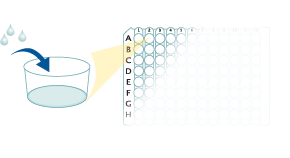
50 µL Standard, Control, or Sample
- Add 50 µL of Standard, control, or sample to each well. Cover with a plate sealer, and incubate at room temperature for 2 hours on a horizontal orbital microplate shaker.
- Aspirate each well and wash, repeating the process 2 times for a total of 3 washes.

200 µL Conjugate
- Add 200 µL of Conjugate to each well. Cover with a new plate sealer, and incubate at room temperature for 2 hours on the shaker.
- Aspirate and wash 3 times.

200 µL Substrate Solution
- Add 200 µL Substrate Solution to each well. Incubate at room temperature for 30 minutes on the benchtop. PROTECT FROM LIGHT.
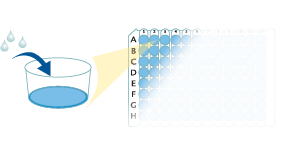
50 µL Stop Solution
- Add 50 µL of Stop Solution to each well. Read at 450 nm within 30 minutes. Set wavelength correction to 540 nm or 570 nm.
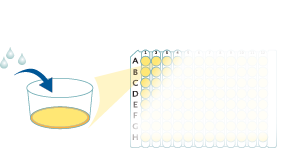
Citations for Human Apolipoprotein B/ApoB Quantikine ELISA Kit
R&D Systems personnel manually curate a database that contains references using R&D Systems products. The data collected includes not only links to publications in PubMed, but also provides information about sample types, species, and experimental conditions.
7
Citations: Showing 1 - 7
Filter your results:
Filter by:
-
Caffeine blocks SREBP2-induced hepatic PCSK9 expression to enhance LDLR-mediated cholesterol clearance
Authors: PF Lebeau, JH Byun, K Platko, P Saliba, M Sguazzin, ME MacDonald, G Paré, GR Steinberg, LJ Janssen, SA Igdoura, MA Tarnopolsk, SR Wayne Chen, NG Seidah, J Magolan, RC Austin
Nature Communications, 2022-02-09;13(1):770.
Species: Human
Sample Types: Serum
-
Preclinical development and phase 1 trial of a novel siRNA targeting lipoprotein(a)
Authors: MJ Koren, PM Moriarty, SJ Baum, J Neutel, M Hernandez-, HS Weintraub, M Florio, H Kassahun, S Melquist, T Varrieur, SM Haldar, W Sohn, H Wang, M Elliott-Da, BM Rock, T Pei, O Homann, J Hellawell, GF Watts
Nature Medicine, 2022-01-13;0(0):.
Species: Cynomolgus Monkey
Sample Types: Serum
-
Glycan Node Analysis of Plasma-Derived Extracellular Vesicles
Authors: SA Walker, JS Aguilar Dí, S Busatto, GA Wurtz, AC Zubair, CR Borges, J Wolfram
Cells, 2020-08-22;9(9):.
Species: Human
Sample Types: Plasma
-
Effects of gastric bypass surgery on postprandial gut and systemic lipid handling
Authors: P Jegatheesa, K Seyssel, N Stefanoni, V Rey, P Schneiter, V Giusti, V Lecoultre, L Tappy
Clin Nutr ESPEN, 2019-11-29;35(0):95-102.
Species: Human
Sample Types: Plasma
-
Differences in plasma fibrin clot composition in patients with thrombotic antiphospholipid syndrome compared with venous thromboembolism
Authors: A Stachowicz, M Zabczyk, J Natorska, M Suski, R Olszanecki, R Korbut, JR Wi?niewski, A Undas
Sci Rep, 2018-11-23;8(1):17301.
Species: Human
Sample Types: Plasma
-
Effect of the catechol-O-methyltransferase inhibitors tolcapone and entacapone on fatty acid metabolism in HepaRG cells
Authors: D Grünig, A Felser, U Duthaler, J Bouitbir, S Krähenbühl
Toxicol. Sci., 2018-08-01;0(0):.
Species: Human
Sample Types: Cell Culture Supernates
-
Lowering Low-Density Lipoprotein Particles in Plasma Using Dextran Sulphate Co-Precipitates Procoagulant Extracellular Vesicles
Authors: JW Wang, YN Zhang, SK Sze, SM van de Weg, F Vernooij, AH Schoneveld, SH Tan, HH Versteeg, L Timmers, CSP Lam, DPV de Kleijn
Int J Mol Sci, 2017-12-29;19(1):.
Species: Human
Sample Types: Plasma
FAQs
-
What forms of ApoB are detected in Human Apolipoprotein B/ApoB Quantikine ELISA Kit, Catalog # DAPB00?
The immunogen for both the capture and the detection in DAPB00 is ApoB100 (aa 1206-1413). Based on amino acid sequences the kit is likely to see ApoB100, B48, B42, B37, and B34. The ApoB29 form is truncated at aa1305 and doesn't encompass the entire region of the immunogen so we are uncertain if this form is detected. A naturally-derived human ApoB, not a recombinant, is used as the standard in this ELISA kit, so it is a mixture of naturally occurring forms. We have not verified by testing each form independently for recognition in the assay.
Reviews for Human Apolipoprotein B/ApoB Quantikine ELISA Kit
Average Rating: 4.3 (Based on 3 Reviews)
Have you used Human Apolipoprotein B/ApoB Quantikine ELISA Kit?
Submit a review and receive an Amazon gift card.
$25/€18/£15/$25CAN/¥75 Yuan/¥2500 Yen for a review with an image
$10/€7/£6/$10 CAD/¥70 Yuan/¥1110 Yen for a review without an image
Filter by:
Serum run at 2000-fold dilution. Plasma run at 1000-fold dilution. Plasma showed good linearity up to 4000-fold dilution.


